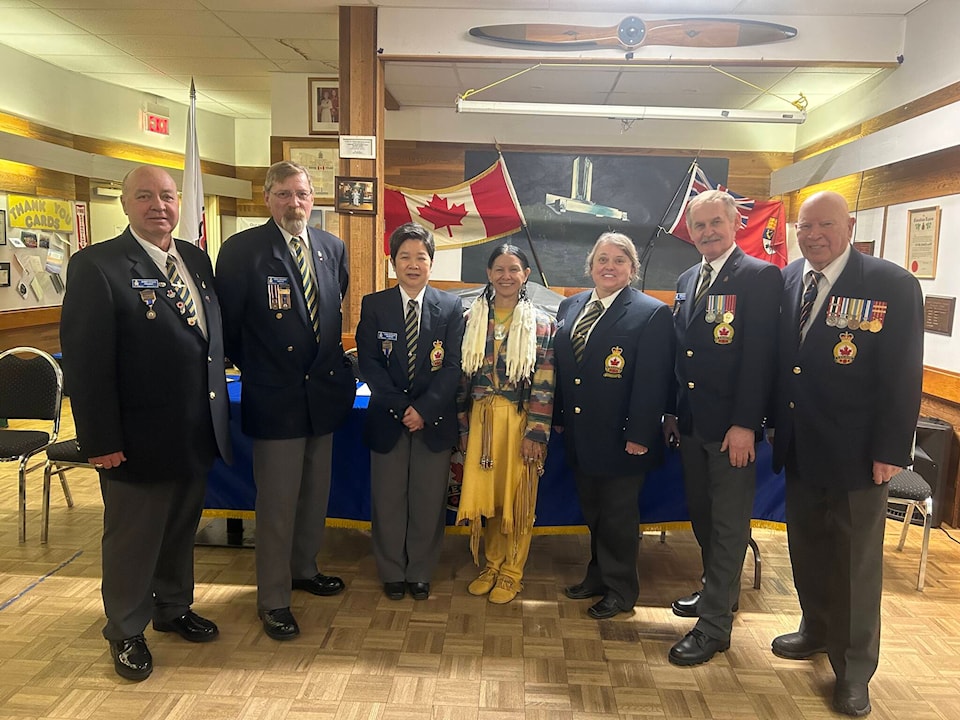By Misha Mustaqeem
Royal Canadian Legion Branch 260 has created a new role that seeks to bridge the gap between Indigenous communities and the Legion.
Last month the Legion officially named Lone Butte resident and Tsq̓éscen̓ First Nation member Karen Pellerin as their first Indigenous Liaison officer. 100 Mile House’s Legion is the first in Western Canada to have such a liaison officer. The only other Legion branch that has an Indigenous liaison officer in Canada is in Quebec.
Bobby Jack-Evans, president of Branch 260, said that Pellerin was chosen due to her experience teaching children in the 100 Mile House area about Indigenous cultures. Pellerin also has a warm and friendly personality that he thinks suits her for the job.
“It’s important that whoever chose that position knows how to or can give that sense of trust to people, and she has that,” Evans remarked.
Pellerin, for her part, has embraced the role though so far she has just performed simple blessing rituals. Her goal, however, is to facilitate communication between Indigenous communities and the Legion.
“(I want) to bring our people and the Legion – whoever else I come into contact with, together,” Pellerin explained.
The branch created the role based on the wish of Bruce Julian, who chairs several committees in the Dominion Command of the Legion. Julian wanted to have more Indigenous representation in the Legion, Evans explained.
“He really wanted to have Aboriginals, First Nations, Innus – all represented within the Legions because during the First World War, Second World War and Korean War, Indigenous people were used because of their language within those wars,” he said, referring to when the government used languages such as Cree to send encoded messages.
The role was created to bridge the gap between Indigenous and non-Indigenous veterans created by the Indian Act. The act barred Aboriginal men from attending functions where alcohol was served. This included every Legion location across Canada as all contained bars that served alcohol.
Indigenous veterans, according to the 1996 Royal Commission on Aboriginal Peoples, were deprived of benefits and other services that non-Indigenous soldiers had. They were also deprived of camaraderie and the informal support networks the Legion provides.
Evans’ grandchildren are partly Indigenous, and when he read about the history of such laws, he became angry.
“When I was reading this, I was like, “wow, so if this was never rescinded and if someone did not do something about this, my grandchildren would not be able to use the Legion’s services. ”
The gap has remained between Indigenous veterans and the Legion despite a 1951 amendment to the Indian Act allowing an Indigenous person to be in possession of alcohol with conditions and a 1985 repeal of all liquor offenses in the Indian Act.
“I think – like anything else with segregation, there might have been feelings of abandonment and people did not want to be a part of an organization such as that,” Evans said.
Yet, Evans remains hopeful it can be filled, especially with Pellerin as the Liaison officer:
“Our hope is that we will start seeing more, and more and more Indigenous people who have served, or family members of those who have served, come to our Legion, and be out there supporting us and our parades, and Poppy Days.”
As for Pellerin, she says she is honoured to be the Indigenous Liaison officer for the Legion branch and looks forward to representing the Indigenous peoples who have been left behind.
“I’m happy to be part of the executive at the Legion. ”
